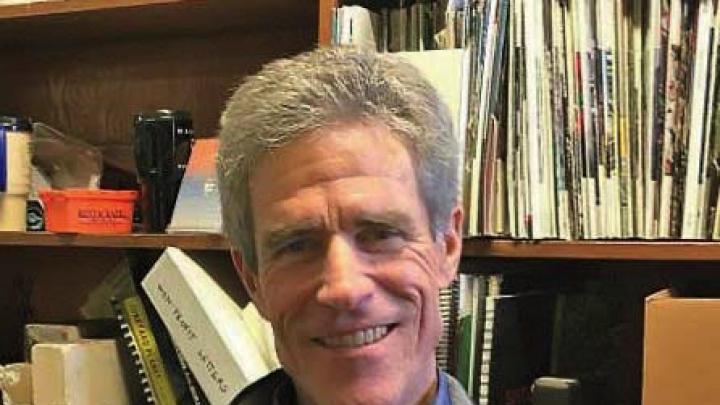Rob Gogan, Harvard’s recycling and waste manager, retired in October, having long done more than anyone else to instill a culture of waste-reduction, reuse (of furniture, for example), recycling, and composting throughout the University.
Helped by friends and correspondents, he also compiled and published a monthly “Nature Watch,” starting in 2001. With Harvard now barely peopled, it seems fitting to share some of his collected observations of the other kinds of life that teem on campus. Nodding to this winter season, Primus has selected a few entries from his January dispatches.
• 2002: “Tendons snap audibly as a hawk perched in a tree in front of Massachusetts Hall dismembers a squirrel rip by rip.”
• 2003: “Red-tailed [hawk] startles pruning arborist high in elm tree on Plympton Street; red-taileds also seen over Anderson Bridge, above the Yard canopy, and in Winthrop House courtyard.”
• 2004: “Great blue heron alights on river walk in front of Peabody Terrace.”
2005: “Big, fuzzy buds on the magnolia tree in front of the Inn at Harvard and small white buds on the Japanese andromeda at 60 JFK Street remind us that spring is practically around the corner!”
• 2013: “Barred owl, resting in a tree beside Boylston Hall near Widener, calls to a second hidden in another tree near Weld Hall on the day before winter break.”
And in 2015, on the interface with humans, when present: “Masked bandit samples food scraps discarded in trash at Harvard Hillel, Eliot House, and Winthrop House. Pest control vendor sets out live traps but the bandit is too elusive and escapes capture.”
Life of all sorts still goes on hereabouts, if perhaps less faithfully recorded. Gogan will have plenty of opportunities for more such observing, as he indulges in sailing, kayaking, hiking, and other “carbon-free outdoor activities.”
Harvard’s world-class rank in producing leaders of the future and life-changing discoveries may pale next to its acronym output, a source of befuddlement to many and amusement to others. Helpfully responding to the problem (or giving in to its overwhelming dimensions), the College has provided a guide to the lingo for students and staff, accessible at https://college.harvard.edu/guides/harvard-terms-and-acronyms. Be sure to look up CPIC or URAF (under offices and locations), HDRB or IB—not what you might think (under academics), and similar delights under the seven categories on offer.
A scholarly mind at work, from the memorial minute on the life and services of the late John Torrance Tate Jr., Perkins professor of mathematics emeritus, presented to the Faculty of Arts and Sciences on October 6, 2020:
His intellectual generosity remains a model for our mathematical community….His notes and letters were often freely circulated—sometimes for decades—while John continued to improve them….The 1,500 pages of his letters with Jean-Pierre Serre, published in two volumes, offer a vivid record of the day-by-day emergence throughout the last half-century of key ideas…many of them forming the shape of modern number theory. The letters are electric with new discoveries, with emotional intensity, and with exuberance….In one of those letters, John writes, “I went on a vacation to the surface V whose equation is [see equation below] following the guide book of Weil. Quel beau lieu!”
And for a view of the scholar as instructor, a letter to the editor from Jay A. Frogel ’66, professor of astronomy emeritus at The Ohio State University, recalls Cecilia Payne-Gaposchkin (Vita, May-June 2020, page 38):
She was a great and inspiring teacher. She was also a chain smoker. So as she was standing at the blackboard she would have between the fingers of one hand a lit cigarette, an unlit one, and a piece of white chalk. Getting deeply engrossed in her lecturing, she would often mix the three up—she’d try to write on the board with one of the cigarettes or to inhale the piece of chalk. Either of these actions would result in rather humorous consequences, all of which she took in stride and never broke her chain of thought.








